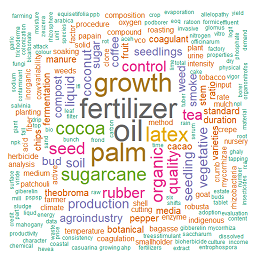Identifikasi Isolat Rhizobakteria Indigenos Kandidat Agen Biokontrol Ganoderma boninense Berdasarkan Sekuen Gen 16S rRNA
DOI:
https://doi.org/10.25181/jaip.v9i1.1494Keywords:
basal stem rot, indigenous rhizobacteria, oil palm nursery management, 16S rRNAAbstract
Rhizobacteria is a group of bacteria that colonize roots, affect growth and control plant pathogens. Based on the results of previous studies, 6 isolates have the best ability to control Ganoderma boninense in oil palm seedlings. It is important to characterize them molecularly. Molecular identifications of the selected rhizobacteria isolates were done using the 16S rRNA gene. The results showed that all isolates were identified to have similarity as 5 different species i.e Bacillus paramycoides, Microbacterium paraoxydans, B. albus, B. cereus, and Serratia marcescens based on NCBI database.Downloads
References
Azizah, S. N., Mubarik, N. R., & Sudirman, L. I. (2015). Potential of chitinolytic Bacillus amyloliquefaciens SAHA 12 . 07 and Serratia marcescens KAHN 15 . 12 as biocontrol agents of Ganoderma boninense. Research Journal of Microbiology, 10(10), 452–465. https://doi.org/10.3923/jm.2015.452.465
Bakhtiar, Y., Yahya, S., & Sumaryono, W. (2012). Adaptation of oil palm seedlings inoculated with arbuscular mycorrhizal fungi and mycorrhizal endosymbiotic bacteria Bacillus subtilis B10 towards biotic stress of pathogen Ganoderma boninense Pat. Jurnal Microbiology Indonesia, 6(4), 157–164. https://doi.org/10.5454/mi.6.4.3
Beneduzi, A., Ambrosini, A., & Passaglia, L. M. P. (2012). Plant growth-promoting rhizobacteria (PGPR): Their potential as antagonists and biocontrol agents. Genetics and Molecular Biology, 4, 1044–1051.
Bivi, M. R., Farhana, M. S., Khairulmazmi, A., & Idris, A. (2010). Control of Ganoderma boninense: A causal agent of basal stem rot disease in oil palm with endophyte bacteria in vitro. International Journal of Agriculture and Biology, 12(6), 833–839.
Bosshard, P. P., Abels, S., Zbinden, R., Böttger, E. C., & Altwegg, M. (2003). Ribosomal DNA sequencing for identification of aerobic gram-positive rods in the clinical laboratory (an 18-month evaluation). Journal of Clinical Microbiology, 41(9), 4134-4140.
Buana, R. F. N., Wahyudi, A. T., & Toruan-Mat, N. (2014). Control activity of potential antifungal-producing Burkholderia sp. in suppressing Ganoderma boninense growth in oil palm. Asian Journal of Agricultural Research, 8(5), 259–268. https://doi.org/10.3923/ajar.2014.259.268
Chen, Y. P., Rekha, P. D., Arun, A. B., Shen, F. T., Lai, W., & Young, C. C. (2006). Phosphate solubilizing bacteria from subtropical soil and their tricalcium phosphate solubilizing abilities. Applied Soil Ecology, 34, 33–41. https://doi.org/10.1016/j.apsoil.2005.12.002
Chong, K. P., Lum, M. S., Foong, C. P., Wong, C. M. V. L., Atong, M., & Rossall, S. (2011). First identification of Ganoderma boninense isolated from Sabah based on PCR and sequence homology. African Journal of Biotechnology, 10(66), 14718–14723. https://doi.org/10.5897/AJB11.1096
Cooper, R.M, Flood J., Rees R.W. 2011. Ganoderma boninense in oil palm plantations: Current thinking on epidemiology, resistance and pathology. Planter, 87(1024): 515–52.
Fredriksson, N. J., Hermansson, M., & Wilén, B. M. (2013). The choice of PCR primers has great impact on assessments of bacterial community diversity and dynamics in a wastewater treatment plant. PloS one, 8(10), e76431.
Glick B. R., Cheng, Z., Czarny, J., & Duan, J. (2007). Promotion of plant growth by ACC deaminase-producingsoil bacteria. Eur J Plant Pathol 119:329-39.
Idris, A., Kushairi, A., Ismail, S., & Ariffin, D. (2004). Selection for partial resistance in oil palm progenies to Ganoderma basal stem rot. J Oil Palm Res., 16(2), 12-18.
Kaur, G., Kaur, J., Dadhich, K. S., & Caemotra, S. S. (2011). Phosphate-solubilizing bacteria Microbacterium paraoxydans isolated from the rhizospheric system of wheat (Triticum aestivum). Transylv. Rev. Syst. Ecol. Res., 12, 149–161.
Khaeruni, A., Sutariati, G. A. K., & Rahman, A.. (2011). Potensi Rizobakteri indigenous Ultisol untuk mengendalikan penyakit busuk batang Phytophthora (Phytophthora capsici) pada tanaman cabai. Jurnal Agroteknos, 1(1), 9-15.
Li, F. X., Ma, H. Q., Liu, J., & Zhang, C. (2012). Antagonistic effects of Bacillus cereus strain B-02 on morphology, ultrastructure and cytophysiology of Botrytis cinerea. Polish Journal of Microbiology, 61(2), 119–128.
Ommelna, B. G., Jennifer, A. N, Chong, K. P. (2012). The potential of chitosan isuppressing Ganoderma boninense infection in oil palm seedlings. JSSM 7(2):186-19.
Petti, C. A., Polage, C. R., & Schreckenberger, P. (2005). The role of 16S rRNA gene sequencing in identification of microorganisms misidentified by conventional methods. Journal of Clinical Microbiology, 43(12), 6123-6125.
Puspita, F, Zul, D., & Khoiri, A. (2013). Potensi Bacillus sp. asal rizosfer Giam Siak Kecil Bukit Batu sebagai rhizobacteria pemacu pertumbuhan dan antifungi pada pembibitan kelapa sawit. Seminar Nasional “Peranan Teknologi dan Kelembagaan Pertanian dalam Mewujudkan Pembangunan Pertanian yang Tangguh dan Berkelanjutan, 2009 (November), 7–15.
Roberts, D. P., McKenna, L. F., Lakshman, D. K., Meyer, S. L. F., Kong, H., de Souza, J. T., … Chung, S. (2007). Suppression of damping-off of cucumber caused by Pythium ultimum with live cells and extracts of Serratia marcescens N4-5. Soil Biology and Biochemistry, 39(9), 2275–2288. https://doi.org/10.1016/j.soilbio.2007.03.029
Rosselló-Mora R, & Amann R (2001) The species concept for prokaryotes. FEMS Microbiol Rev 25(1):39–67.
Sanderson, F. R. (2005). An insight into spore dispersal of Ganoderma boninense on oil palm. Mycopathologia, 159(1), 139–141. https://doi.org/10.1007/s11046-004-4436-2
Simmon, K. E., Mirrett, S., Reller, L. B., & Petti, C. A. (2008). Genotypic diversity of anaerobic isolates from bloodstream infections. Journal of Clinical Microbiology, 46(5), 1596-1601.
Suryanto, D., Wibowo, R. H., Siregar, E. B. M., & Munir, E.. (2012). A possibility of chitinolytic bacteria utilization to control basal stems disease caused by Ganoderma boninense in oil palm seedling. African Journal of Microbiology Research, 6(9). https://doi.org/10.5897/AJMR11.1343
Susanto, A., Prasetyo, A. E., Priwiratama, H., Wening, S., & Surianto, S. (2013). Ganoderma boninense penyebab penyakit busuk batang atas kelapa sawit. Jurnal Fitopatologi Indonesia, 9(4), 123-123. https://doi.org/10.14692/jfi.9.4.123
Tan, Z., Hurek, T., Vinuesa, P., Müller, P., Ladha, J. K., & Reinhold-Hurek, B. (2001). Specific detection of Bradyrhizobium and Rhizobium strains colonizing rice (Oryza sativa) roots by 16S-23S ribosomal DNA intergenic spacer-targeted PCR. Applied and Environmental Microbiology, 67(8), 3655-3664.
Vishwakarma, K., Kumar, V., Tripathi, D. K., & Sharma, S. (2018). Characterization of rhizobacterial isolates from Brassica juncea for multitrait plant growth promotion and their viability studies on carriers. Environmental Sustainability, 1(3), 253–265. https://doi.org/10.1007/s42398-018-0026-y.
Webster, G., Newberry, C. J., Fry, J. C., & Weightman, A. J. (2003). Assessment of bacterial community structure in the deep sub-seafloor biosphere by 16S rDNA-based techniques: a cautionary tale. Journal of Microbiological Methods, 55(1), 155-164.
Yanti, Y., Arnetti, A., & Rifai, I. (2019). Penapisan isolat rizobakteri indigenos untuk pengendalian Ganoderma boninense pada bibit kelapa sawit (Elaeis guineensis Jacq.). Jurnal Agro Industri Perkebunan, 7(2), 59-68. https://doi.org/10.25181/jaip.v7i2.1156
Zahid, M., Abbasi, M. K., Hameed, S., & Rahim, N. (2015). Isolation and identification of indigenous plant growth promoting rhizobacteria from Himalayan region of Kashmir and their effect on improving growth and nutrient contents of maize (Zea mays L.). Frontiers in Microbiology, 6, 1-10. https://doi.org/10.3389/fmicb.2015.00207
Downloads
Published
How to Cite
Issue
Section
License
Copyright (c) 2021 Yulmira Yanti, Nurbailis, Imam Rifai

This work is licensed under a Creative Commons Attribution-ShareAlike 4.0 International License.
Authors who publish with Jurnal Agro Industri Perkebunan agree to the following terms:
Authors retain copyright and grant the Jurnal Agro Industri Perkebunan right of first publication with the work simultaneously licensed under a Creative Commons Attribution License (CC BY-SA 4.0) that allows others to share (copy and redistribute the material in any medium or format) and adapt (remix, transform, and build upon the material for any purpose, even commercially) with an acknowledgment of the work's authorship and initial publication in Jurnal Agro Industri Perkebunan.
Authors are able to enter into separate, additional contractual arrangements for the non-exclusive distribution of the journal's published version of the work (e.g., post it to an institutional repository or publish it in a book), with an acknowledgment of its initial publication in Jurnal Agro Industri Perkebunan. Authors are permitted and encouraged to post their work online (e.g., in institutional repositories or on their website) prior to and during the submission process, as it can lead to productive exchanges, as well as earlier and greater citation of published work.


























